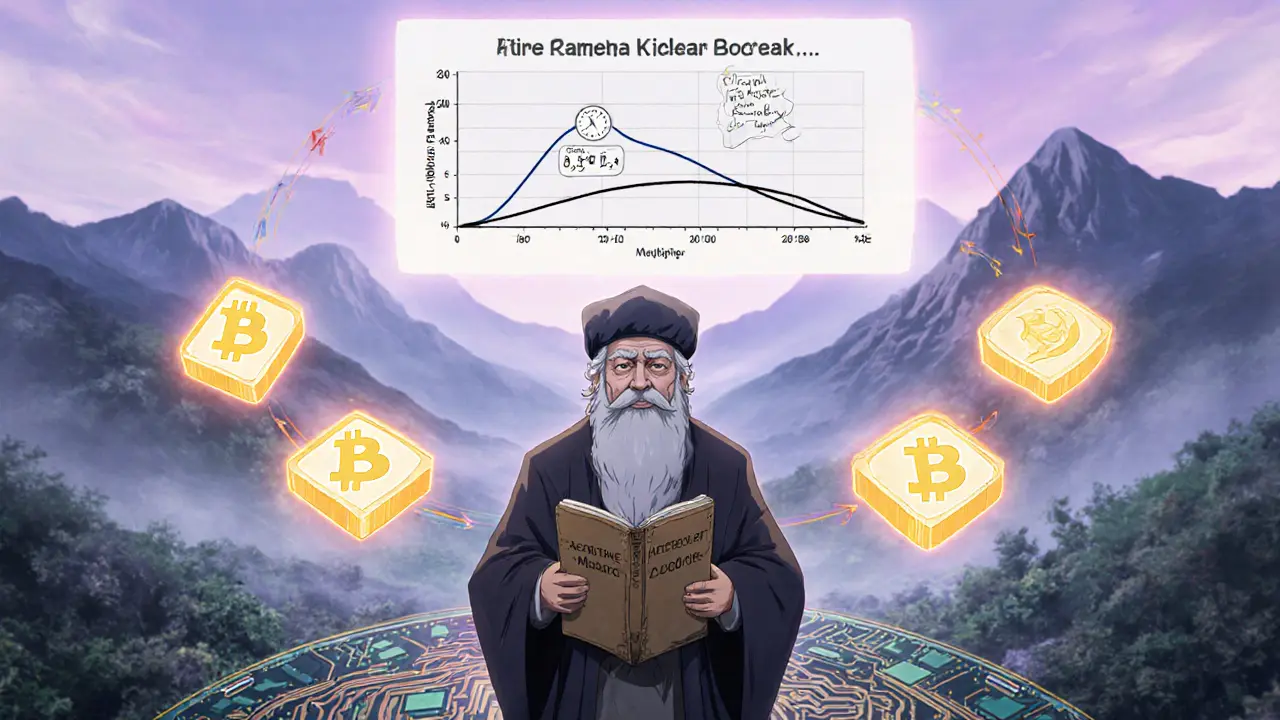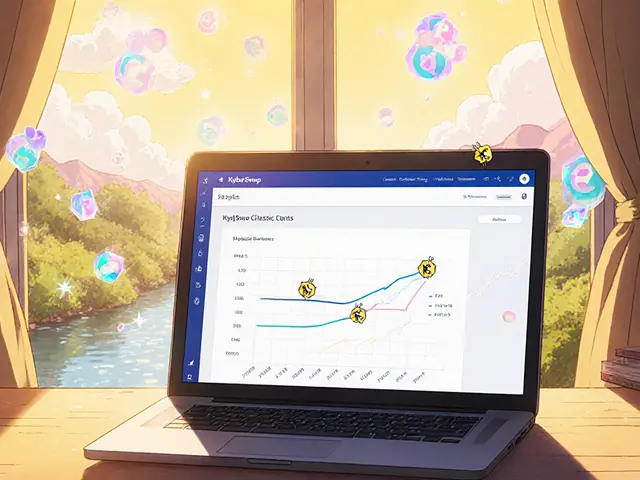7
Understanding Mining Difficulty in Blockchain Networks

When you hear people talk about how hard it is to mine a new block, they’re really referring to mining difficulty is a metric that determines how much computational work a miner must perform to find a valid block hash. This number isn’t static; it shifts automatically to keep block creation on schedule, no matter how many miners join or leave the network.
Key Takeaways
- Mining difficulty is an algorithmic gauge that ensures consistent block times.
- Bitcoin recalculates difficulty every 2,016 blocks (≈2 weeks) using the previous period’s hash rate.
- Factors like hash rate, hardware upgrades, and market price directly affect difficulty.
- Higher difficulty boosts network security but can squeeze out small‑scale miners.
- Different blockchains use varied adjustment formulas - Bitcoin, Ethereum (pre‑PoS), Dogecoin are prime examples.
How Mining Difficulty Works
At its core, Proof‑of‑Work is a consensus method where miners solve a cryptographic puzzle. The puzzle requires finding a hash value that is lower than a target number. The lower the target, the harder the puzzle, which translates to a higher difficulty level.
Every successful miner packages pending transactions into a block, broadcasts it, and earns the block reward plus fees. If the network’s total computing power - the hash rate - spikes, blocks would be found faster than intended. To prevent runaway block times, the protocol raises the difficulty, shrinking the target and forcing miners to work harder.
Bitcoin’s Difficulty Adjustment Formula
Bitcoin’s original design, credited to Satoshi Nakamoto, recalculates difficulty after 2,016 blocks. The network compares the actual time taken for those blocks against the ideal 20,160 minutes (2 weeks at 10 minutes per block). The new difficulty = old difficulty × (actual time / 20,160 minutes), constrained to a 4× increase or 0.25× decrease.
This safeguard prevents extreme swings. For example, if miners collectively double their hash rate over a week, the difficulty won’t jump more than fourfold in the next adjustment, avoiding a sudden slowdown that could lead to orphaned blocks.
Factors That Influence Difficulty Changes
Network hash rate is the primary driver. When more miners join - often sparked by a price rally - the hash rate climbs, and difficulty follows suit. Conversely, a market crash pushes marginal miners offline, lowering hash rate and easing difficulty.
Hardware evolution also matters. The shift from CPUs to GPUs to specialized ASIC miners has boosted hash rate dramatically, forcing difficulty to leap upward during each adjustment period.
Geography plays a subtle role. Regions with cheap electricity (e.g., certain provinces in China before 2021, later Texas and Kazakhstan) attract large mining farms, feeding the global hash rate. Regulatory crackdowns or renewable‑energy incentives can swing regional contributions, nudging overall difficulty.

Impact on Security and Economics
Higher difficulty means a higher total hash rate, which raises the cost of a 51% attack. In practice, attacking a network like Bitcoin would require controlling dozens of exahashes per second - an astronomical expense.
From a miner’s perspective, difficulty directly hurts profitability when hardware costs, electricity rates, or coin prices don’t keep pace. Small operators often become unprofitable during high‑difficulty phases and either join mining pools or shut down. Pools mitigate variance by pooling resources and sharing rewards proportionally, but they also adjust payout structures based on difficulty trends.
Transaction fees are indirectly affected. When difficulty spikes, miners may prioritize higher‑fee transactions to offset lower block rewards, pushing average fees upward during congestion periods.
Comparing Difficulty Adjustment Algorithms
| Blockchain | Adjustment Frequency | Formula Highlights | Pros | Cons |
|---|---|---|---|---|
| Bitcoin | Every 2,016 blocks (~2 weeks) | Targets 10‑minute block time; caps change at 0.25×‑4× | Stable, predictable; resistant to manipulation | Can lag during rapid hash‑rate swings, causing short‑term block‑time volatility |
| Ethereum (pre‑PoS) | Every block | Uses exponential moving average of previous block times | Fast reaction to hash‑rate changes | More volatile block times; higher risk of “difficulty bomb” exploits |
| Dogecoin | Every 2,016 blocks, but also uses a secondary adjustment every 10 blocks | Blends long‑term and short‑term averages | Balances stability and responsiveness | Complexity can confuse miners; occasional spikes in block time |
Practical Guidance for Miners
Before buying hardware, run a mining calculator that inputs current difficulty, electricity cost, and expected hash rate. Look at difficulty trends over the past six months - a steady upward slope signals rising competition.
If you’re a solo miner, monitor difficulty closely; a sudden 2× jump could double your breakeven power consumption overnight. Joining a mining pool can smooth earnings, but check the pool’s fee schedule - many adjust fees based on difficulty to keep payouts fair.
Consider geographic diversification. Some regions offer surplus renewable energy at lower rates, which can offset higher difficulty periods by reducing electricity expense.
Future Trends and Research
Bitcoin’s difficulty algorithm has proven resilient, but researchers propose tweaks like Kimoto Gravity Well or multi‑interval averaging to improve responsiveness. However, community consensus is hard to achieve, so major changes are rare.
Environmental concerns are pushing developers toward hybrid models-combining PoW for security with PoS for efficiency. Projects experimenting with proof‑of‑useful‑work aim to align mining effort with real‑world computation, potentially redefining what “difficulty” means.
As Ethereum’s shift to proof‑of‑stake removed mining difficulty from the second‑largest cryptocurrency, miners have migrated to alternative networks, slightly easing Bitcoin’s hash‑rate growth. Keep an eye on emerging PoW chains; their difficulty curves can offer profitable niches for smaller players.

Frequently Asked Questions
Why does Bitcoin adjust difficulty only every two weeks?
A two‑week window smooths out short‑term fluctuations in hash rate, preventing miners from gaming the system by temporarily adding or removing power. It also reduces the computational overhead of constantly rewriting the target value.
Can I predict future difficulty?
Only roughly. Analysts use trends in hash rate, hardware releases, and price forecasts to model difficulty, but sudden regulatory changes or large‑scale hardware failures can cause unexpected shifts.
How does difficulty affect transaction fees?
When difficulty rises, miners earn fewer blocks per day, so they prioritize higher‑fee transactions to maintain revenue, pushing the average fee upward during high‑difficulty periods.
Is a higher difficulty always better for network security?
Generally yes, because it means more hash power protecting the chain, making attacks costlier. However, if difficulty climbs faster than the ecosystem’s ability to stay decentralized, it can lead to centralization, which introduces its own risks.
Do all proof‑of‑work blockchains use the same difficulty formula?
No. Bitcoin uses a 2,016‑block interval, Ethereum (pre‑PoS) adjusted every block, Dogecoin employs a hybrid approach, and many newer chains experiment with adaptive or multi‑parameter formulas.










OLAOLUWAPO SANDA
July 7, 2025 AT 07:10Mining difficulty is just a Western ploy to keep the little guys out.
Alex Yepes
July 10, 2025 AT 18:35While the exposition on difficulty adjustment is thorough, it would benefit from a concise summary at the outset. Moreover, the historical context of Bitcoin’s design choices underscores its resilience. Readers should note that the 4× cap mitigates volatility, thus preserving user confidence. In practice, this mechanism has proved effective across multiple market cycles.
Sumedha Nag
July 14, 2025 AT 05:59Honestly, I think everyone overstates how scary higher difficulty is. First, difficulty is just a number that the network uses to keep block time stable, nothing more. Second, miners adapt by upgrading hardware, which is a normal market response. Third, the notion that difficulty "squeezes out" small miners ignores the fact that many of those miners can join pools and still be profitable. Fourth, the frequent adjustments actually protect the network from sudden hash‑rate spikes that could cause instability.
Fifth, the algorithm’s caps (0.25× to 4×) prevent extreme swings, a design decision that’s often praised by economists. Sixth, the security benefits of higher difficulty are undeniable; a 51% attack becomes astronomically expensive. Seventh, the trade‑off between security and decentralization is a nuanced discussion, not a binary choice.
Eighth, regional electricity costs dramatically affect profitability, so difficulty alone isn’t the sole factor. Ninth, the shift to ASICs has already reduced the barrier for small‑scale participants, as they can rent hash power in the cloud. Tenth, mining calculators that factor in difficulty give a realistic break‑even point, which many newcomers ignore.
Eleventh, the market has seen cycles where difficulty rose, yet price appreciation compensated miners. Twelfth, the existence of mining pools ensures that even during high‑difficulty periods, rewards are smoothed out. Thirteenth, the community continually debates PoW versus PoS, but PoW’s difficulty mechanism remains a cornerstone of security.
Fourteenth, with the upcoming developments in useful‑work mining, the definition of difficulty may evolve, potentially aligning incentives better. Fifteenth, overall, difficulty is a tool, not a tyrant, and understanding its dynamics demystifies a lot of the hype surrounding mining.
Holly Harrar
July 17, 2025 AT 17:24Great breakdown! Just a heads up, you might want to double‑check the 2‑week figure – it’s actually 20160 minutes, not 20,160. Also, when you talk about hardware upgrades, don’t forget to mention GPUs – they still matter for some alt‑coins. Definately add a link to a mining calculator for beginners. Overall, solid work, keep it up!
Vijay Kumar
July 21, 2025 AT 04:48This is a solid primer for anyone curious about PoW. I’d suggest keeping an eye on upcoming difficulty trends before buying new rigs. Also, consider the electricity rates in your area – they can make or break profitability. Thanks for the comprehensive guide!
Edgardo Rodriguez
July 24, 2025 AT 16:13From a historical perspective, the difficulty adjustment mechanism serves as a self‑regulating feedback loop, ensuring that block intervals remain approximately constant, thereby preserving network stability; this is crucial, especially when considering the massive influx of hash power that can occur after major price rallies.
Moreover, the cap on adjustment – limited to a quarter or four times the previous difficulty – acts as a safeguard against sudden volatility, preventing erratic swings that could otherwise destabilize the blockchain’s consensus.
It is also worth noting that different blockchains have experimented with alternative algorithms, such as the Kimoto Gravity Well, which aims to respond more quickly to hash‑rate changes, though these often introduce additional complexity.
In practice, miners must continuously monitor both the difficulty and the market price to make informed decisions about hardware upgrades, pool participation, and operational costs.
Ultimately, this dynamic interplay between difficulty, hash rate, and economic incentives underpins the resilience and security of PoW networks.
Andrew Else
July 28, 2025 AT 03:37Yeah, because reading a 10‑minute tutorial is the only way to become a miner. 🙄
Good luck with that.
Susan Brindle Kerr
July 31, 2025 AT 15:02Wow, another endless essay on difficulty. As if we needed more jargon. Honestly, I think most people just care about whether they can make a quick profit.
If you ask me, the whole thing is overhyped.
People should focus on real usage, not these numbers.
But alright, keep writing.
Maybe next time you’ll add some drama.
Elmer Detres
August 4, 2025 AT 02:26Hey, great job laying out the basics! 👏 Remember, staying motivated is key – the network will keep adjusting, but your hustle should stay steady. Keep learning, keep mining, and don’t let the difficulty scare you! 💪😊
Tony Young
August 7, 2025 AT 13:51What a dramatic deep‑dive! 🌟 The way you explained the 4× cap felt like a thriller climax. Just a tip: adding a visual chart could make those numbers pop even more. Keep the passion alive, and happy mining! :)
Fiona Padrutt
August 11, 2025 AT 01:15Honestly, it's about time someone highlighted how this system favors our nation’s energy policies. Our cheap power should give us an edge in the global hash race. Let’s keep pushing for more mining farms here!
Briana Holtsnider
August 14, 2025 AT 12:40The analysis feels overly optimistic. In reality, the difficulty spikes often lead to centralization, as only the biggest players survive. This risk is seldom addressed in such over‑glossy narratives.
Also, the environmental impact remains a dark horse that cannot be ignored.
Finally, the shift to PoS on Ethereum shows the market’s desire to move away from wasteful PoW models.
Corrie Moxon
August 18, 2025 AT 00:04Thanks for the balanced view. I appreciate the nuance about both security and decentralization.
Staying optimistic while acknowledging challenges is the right approach.
Looking forward to more insights!
Jeff Carson
August 21, 2025 AT 11:29Interesting take on the adjustment intervals. It’s clear that the 2‑week window smooths out short‑term shocks, which is beneficial for network stability. I also liked the note about regional energy costs – it’s a factor many overlook.
Anne Zaya
August 24, 2025 AT 22:53Cool post! Love the casual vibe.
Emma Szabo
August 28, 2025 AT 10:18What a vibrant exposition! Your description of difficulty as the “heartbeat of the blockchain” really paints a picture. The way you juxtaposed security and economics is both insightful and poetic. Keep sprinkling that colorful language – it makes technical topics sparkle.
Fiona Lam
August 31, 2025 AT 21:42Honestly, this whole difficulty thing is just a buzzword. People make it sound way more complicated than it is.
If you’re not mining, you don’t need to worry.
Enough with the tech jargon already.
mudassir khan
September 4, 2025 AT 09:07While the exposition attempts thoroughness, it conspicuously neglects the inherent inefficiencies, the excessive energy consumption, and the resultant ecological burdens, which, in my view, merit far greater emphasis, particularly given the environmental crises that currently pervade global discourse.
Moreover, the purported security advantages, though theoretically sound, must be balanced against the centralizing pressures exerted by rising difficulty, a nuance insufficiently explored herein.
The article could benefit from a more critical lens, integrating independent research, and providing concrete mitigation strategies, rather than merely cataloguing procedural mechanics.
Bianca Giagante
September 7, 2025 AT 20:31Appreciate the comprehensive overview; however, it would be beneficial to incorporate a more balanced discussion of both the positives and the drawbacks, especially regarding energy usage and decentralization risks.
Including comparative data from other consensus mechanisms could further enrich the analysis.
Jared Carline
September 11, 2025 AT 07:56It is my considered opinion that the prevailing emphasis on mining difficulty, while technically accurate, obscures the larger geopolitical implications of resource allocation and national energy strategies.
raghavan veera
September 14, 2025 AT 19:20Thinking about difficulty makes me wonder how much of our tech is really about solving puzzles versus shaping power structures. The adjustment mechanisms, in a way, echo broader societal rhythms of balance and tension.
Danielle Thompson
September 18, 2025 AT 06:45Great job – keep it up! 😊